An Osaka travel guide that answers all your questions as a first time visitor. How to get to the city, the diversity of things to do in Osaka plus where to eat, play and stay. We’ll share the most popular places that should not be missed alongside some personal favourites you might not find in the guidebooks.
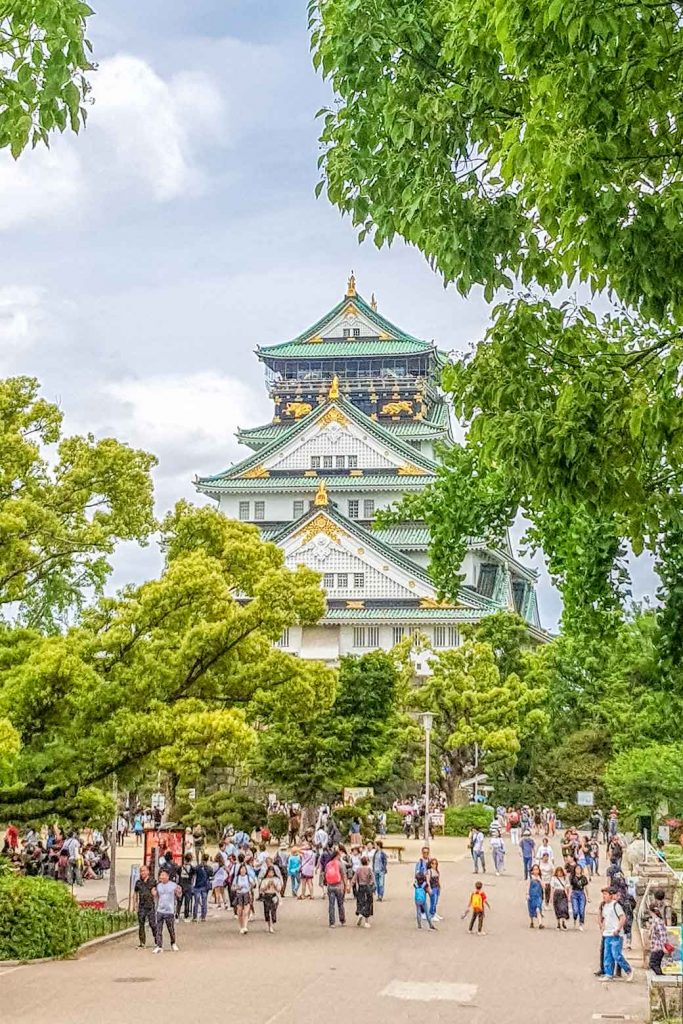
Osaka is Japans third-largest city. It’s modern, vibrant and has a lot to offer the visitor. The vibe and culture of Tokyo and Osaka are very different, even if you’ve already spent time in Tokyo you’ll find Osaka well worth a visit and spending some time in. Osaka is also a great base for exploring the wider Kansai region.
Osaka has been known as Japan’s kitchen since the Edo period making it a must for the travelling foodie. It also has some great gardens and natural places, interesting history, culture, festivals and attractions. In this article, we’ll cover all you need to know about planning your visit based on multiple trips to the city over the years. If you have a question we haven’t addressed please ask in the comments section at the bottom or send us a message through the contact page, we’d be happy to help.
Table of Contents
- Things to do in Osaka
- 1. Explore Dotonbori
- 2. Step back in time at Osaka castle
- 3. See the views from the Umeda Sky Building
- 4. Take the Aqualiner cruise on the river
- 5. Minoo Falls and Park
- 6. Hozenji temple and Yokocho, an Edo style shopping street
- 7. Daisen Park, gofun and Japanese garden in Sakai
- 8. Eat your way through Kuromon Market
- 9. Osaka Aquarium Kaiyukan
- 10. Universal Studios
- 11. Dotonbori and Shinsekai food tour
- 12. Harukas 300 Observatory
- Eating in Osaka
- Day trips from Osaka
- When to visit Osaka?
- Getting to and around Osaka
- Where to stay in Osaka
Things to do in Osaka
1. Explore Dotonbori
This popular destination in Namba runs along the Dotonbori canal between the Nipponbashi and Dotonboribashi bridges. The main activity in Dotonbori is EATING. You’ll find everything from Michelin-starred restaurants to cheap but delicious street food.
It’s fun to wander around at any time of day but especially at night when the neon lights are beaming bright and reflected on the water. Make sure to watch out for the Glico running man, this neon sign has been lighting up the site since 1935 although it’s had a few overhauls and updates to reflect sporting events and teams in Japan over the years. It’s among the most photographed icons in Osaka.
2. Step back in time at Osaka castle
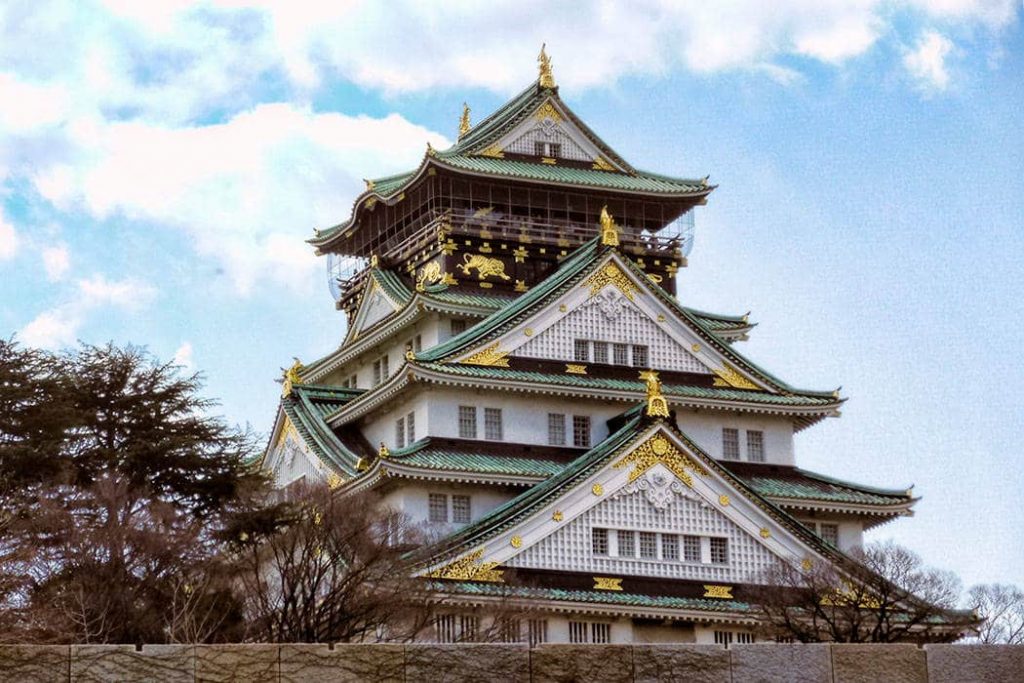
A visit to Osaka Castle can leave you feeling as if you’ve stepped back in time to feudal Japan. Although it’s not one of the few remaining original castles having been lost during WWII, it’s a dramatic part of the city landscape.
Inside the castle is a museum and if you make your way to the top the view of the city is surprisingly good from here. The park and gardens retained around the castle are extensive and give an insight into how the feudal leaders were able to defend their position even from a flatland castle.
The gardens are pretty in all seasons. It’s a top-rated spot for the cherry blossoms and autumn leaves but we also enjoyed the fragrant and colourful winter plum blossom display when the rest of the landscape was a stark contrast.
You’ll find more tips on what to see and do when visiting Osaka Castle in this post.
3. See the views from the Umeda Sky Building
Something we love to do when we head to a new destination is to find the high point and get a perspective from above. It’s usually quite spectacular and helps us in the days that follow to understanding the layout of the area a little better.
In Osaka not only will you get incredible views from the Umeda Sky Building of the surrounding city, suburbs and rivers but the building itself is a work of art. We had the Osaka Amazing Pass on our first visit to the city so headed up the massive escalators of the Umeda Sky Building in the late afternoon for daytime views then settled into the bar for a drink so we could watch the daylight fade and the city light up for the evening. Osaka city is massive and from up here you truly get an appreciation for that.
Check prices and inclusions for the Osaka Amazing Pass
4. Take the Aqualiner cruise on the river
Another inclusion in the Osaka Amazing Pass is the Aqualiner cruise on the river although you can also book it as an individual trip. The tour takes around an hour through the riverways of Osaka passing by points of interest such as Osaka Castle and Nakanoshima.
The perspective of the city from the water adds another dimension to your experience of Osaka. The Aqualiner you travel in is quite unique, it’s futuristic looking and sits low in the water but in order to pass under some of Osaka’s low bridges, you will be asked to stay in your seat at some points while the roof is hydraulically lowered even further so you can glide underneath.
5. Minoo Falls and Park
An easy day trip from the city is Minoo Falls and park. While beautiful in all seasons it is possibly Osaka’s top spot for the autumn colour. It’s an easy walk on paved paths. You are going uphill most of the way to the falls but the gradient is gentle.
In addition to the natural beauty along the way, you’ll pass traditional shopping streets and inns, a free foot hot spring to revive tired feet on the way home, a Shinto Shrine and a Buddhist temple.
At the top of the trail, you’ll come to the dramatic Minoo Falls although on the day we went we were stopped short of the final destination as the track had been closed for repair following damage by a typhoon so we had to settle for smaller falls like these along the way, still very pretty and a highly recommended way to spend the day.
6. Hozenji temple and Yokocho, an Edo style shopping street
Osaka city doesn’t have the visible history of nearby cities such as Kyoto or Nara having suffered heavy bombing during WWII that resulted in much of it being rebuilt after 1945. So it’s worth making a small detour for gems like Hozenji temple and Yokocho.
This small temple is tucked away at the intersection of narrow laneways in the middle of Namba that you may not find unless you know it’s there or like us you are regularly diverted by food.
A ‘yokocho’ is literally an alleyway that runs off the main street. This one it’s a narrow stone-paved lane lined with traditional izakaya-style restaurants that you simply have to try.
The small temple was established in 1637 and is known for its Fudo statue completely covered in moss. Fudo is a guardian, one of the 5 wisdom kings in Buddhism and this statue was one of the few things to survive the extensive bombing in the area.
Seen as a positive omen the rest of the temple and Yokocho were soon rebuilt around it. It’s unusual to see something covered in moss like this in the middle of a city but it also makes it quite special. It’s normal practice at a shrine in Japan to toss a coin into an offering box before prayer. At this shrine it is thought initially those who had no offering would instead ladle water over the statue. Over time that became the norm and the result was that the constantly wet statue in the shade of the city buildings was softened by a lush mossy covering.
7. Daisen Park, gofun and Japanese garden in Sakai
Another short trip from the centre of the city will take you to the suburb of Sakai. This area has preserved the ancient history of Japan dating back to the 5th century when the people built vast symmetrical keyhole-shaped burial mounds.
These tombs while much shorter than the great pyramids of Egypt are greater in volume and show the same organisation, respect and impressive engineering feats for the time. There is kofun found in other areas of Japan including Tokyo and Okayama but those at Sakai are the largest, in the greatest number and therefore the most historically significant.
While in Sakai make a visit to the municipal office, the public area offers great views of the city and is the best way to see the scale of the kofun from above. I really enjoyed the walk from the station through the residential neighbourhoods to the kofun and Daisen Park but you could take a taxi or bus.
Another must-see attraction in Sakai, located within Daisen Park, is the traditional Japanese gardens and teahouse overlooking the lake. While not on any official ‘best 3″ list I know of these are very high on our top gardens in Japan list and we’ve been to a lot now, we highly recommend them if you are in Osaka, especially for the autumn colours.
8. Eat your way through Kuromon Market
One of the best ways to get to know a city is through its food, that’s especially true when the city is known as Japan’s kitchen. That’s why one of our top things to do in Osaka is spending time at Kuromon Ichiba Market in Namba. This market supplies both the commercial restaurant trade and the Mums and Grandmas of Osaka. It’s also now a popular place for tourists to visit so I’d suggest getting there soon after it opens at 9 am.
Fish traders have operated in the area since the early 19th century but the market wasn’t established until 1902, today it’s still known for the variety and quality of its seafood but its 200+ stores offer far more variety.
Something we loved about this market is that it is so well set up to purchase and eat as you wander around and the places offer many sample-sized options so you don’t need to eat a full meal in one place.
This post will show you why the Kuromon market is an absolute must on your itinerary.
9. Osaka Aquarium Kaiyukan
The Osaka Aquarium is out in the Osaka Bay area. The entirely indoor facility is a great option if you strike some wet weather and kids love it. It includes 15 large aquarium tanks including the massive central tank.
We enjoyed the theming of this aquarium with each tank representing one region from around the Pacific Rim, we found some of the less popular exhibits including the pufferfish, giant Japanese spider crabs and all sorts of jellyfish among the most interesting.
This is the best deal for the aquarium tickets we’ve found and you can show the ticket on your phone so you don’t need to print it out.
While out here you will also find the departure point for the harbour cruise ship Santa Maria, the Temporan giant Ferris wheel and Legoland. These activities are all included in the Osaka Amazing Pass, we discuss the value of the pass and our sample itinerary.
10. Universal Studios
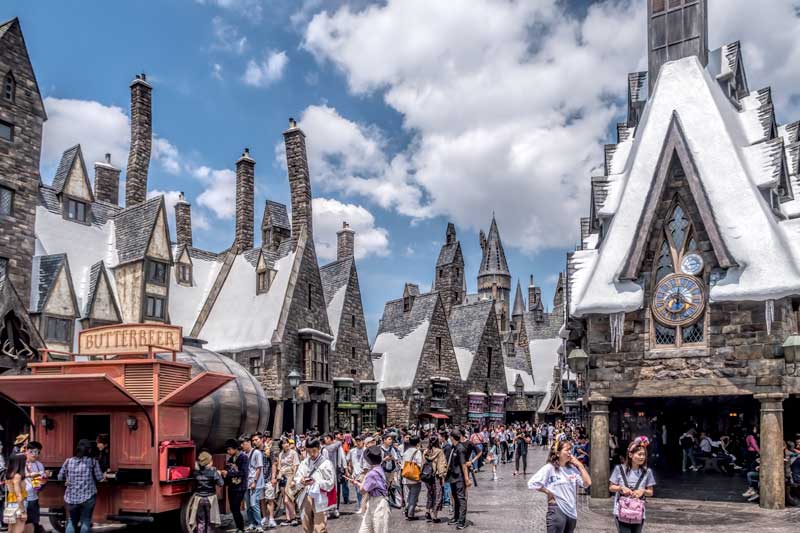
While Tokyo has Disney, Osaka has Universal Studios. Universal Studios Japan is a large and popular park that’s easily accessed by train from within Osaka or surrounding cities.
It features a wide variety of rides and attractions themed on popular movies including the Minions, Spiderman and Jurassic Park but it’s the Wizarding World of Harry Potter that makes this unmissable for every Hogwarts fan young and old.
All the fabulous magical locations are here, flourish your wand and cast special spells as you move around the park then grab a butterbeer. It’s highly recommended to stay for it to get dark and the night parade, this place is even more magical after sunset.
Check Universal Studios Osaka ticket prices here
11. Dotonbori and Shinsekai food tour
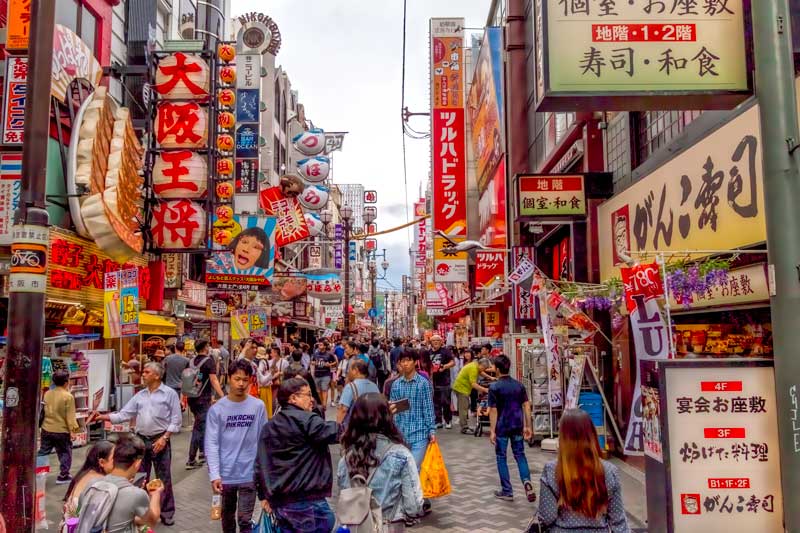
Osaka has a strong food heritage and some unique Japanese dishes have originated here. There are so many small restaurants and stalls selling snacks in the area that it’s hard to pick between them.
Taking a small-group food tour of these areas will help you narrow down the best options and stores but more importantly, it will introduce the history and evolution of the Osaka food culture.
We share more about the tour we did with Magical Trip together with some of the places we love to eat in Osaka in the linked article.
12. Harukas 300 Observatory
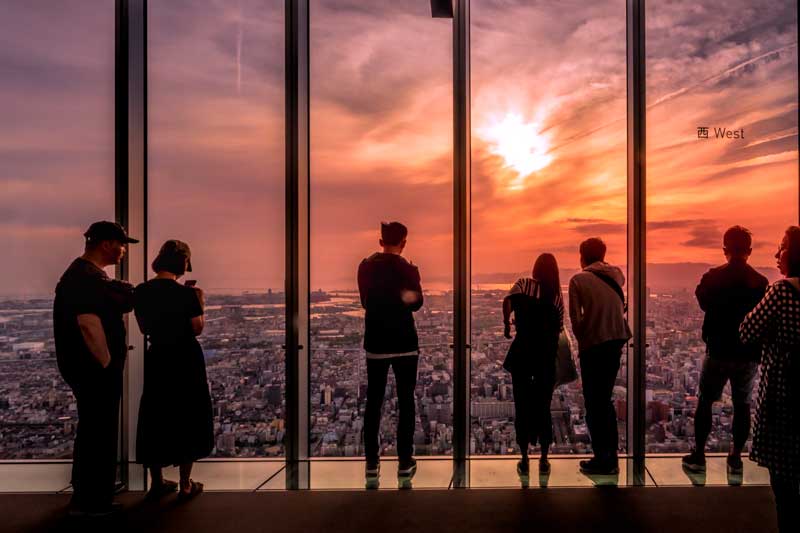
A top spot to get views out over Osaka and as far as the neighbouring cities of Kobe and Nara is the Harukas 300 observatory. This is a newer option and the tallest skyscraper in Japan so the view is truly impressive from the top.
We’ve written a full article on the Harukas 300 observatory but there is much more to do here than you might expect. We had so much fun leaning out over the city from the roof on The Edge experience and their regular special events are great for the whole family.
Eating in Osaka
They call Osaka ‘Japan’s Kitchen’ for good reason, there is delicious food to be found here at all price points but then we find that to be the case everywhere we’ve travelled in Japan and each city or region has its claim to fame in the food space.
Crab restaurants
Eating crab is extremely popular in Japan, especially in autumn and winter when the catch is in season. Although I associate the freshest crab with Hokkaido’s icy cold water, the crab restaurants seem even more popular here in Osaka.
You’ll find an astounding selection of restaurants specialising in the crustacean, among them is Konidoraku Honten Osaka one of the city’s most iconic restaurants. If you’ve spent more than an hour in the city you are bound to have noticed this place in Dotonbori, that giant mechanical crab is a real give away but contrary to appearances perhaps the crab is fresh and it gets excellent reviews.
A good meal of crab can be quite expensive, so you want to look around and choose your restaurant. Many of the restaurants offer a set menu comprising a variety of small dishes to taste the crab in different ways, both hot and cold. You may also notice that many serve a very similar menu at lunchtime but for a significantly lower price than in the evening, this is common in Japan and a top tip to stretch your budget.
Okonomiyaki
Okonomiyaki translates as something like “grilled as you like it” and it is a reasonable description. These delicious creations can be found all over Japan with local twists but the best in my view will always be the Osaka style.
They are a mix of finely sliced cabbage, a batter that looks similar to what you’d use to make pancakes and some magic with toppings and additions of your choice. The magic is that they taste nothing like a pancake or cabbage for that matter. I can’t begin to list the places we’ve eaten these, everywhere from the food carts at festivals to some fairly fancy modern bars.
My pick in Namba is Hozenji-Yokocho Yakizen, an izakaya bar in the narrow laneway leading down to the historic hidden temple. Another excellent option is Botejyu which now has branches around the country but their original is here on the main street of Dotonbori up on the second floor.
Takoyaki
Street food isn’t a common thing in Japan generally, it’s really not done to stand or walk around while you eat and yet Osaka is the home of Takoyaki, something I would classify as the perfect snack food. These small dumplings with a piece of octopus (tako) in the centre of a soft batter ball are delicious. They are fried while being flipped inside a half-circle grill plate to form a perfectly symmetrical little sphere. They are then topped with mayonnaise and bonito flakes.
If you’re as addicted to this tasty treat as much as I am you can pretty much do a Takoyaki crawl of the city to find the best of the best. Some like Aizuya snagged a mention in a Michelin guide publication a few years back but that’s no guarantee it’ll be your favourite.
There are so many variations available depending on whether you prefer the octopus to be chewy or tender, the batter slightly oozy or firm, the outside just sealed or crispy and of course, new fillings and toppings are popping up on menus everywhere. A bit like my gyoza I’m a traditionalist by preference but that won’t stop me from trying the variants. I always have room for takoyaki.
Breakfast or lunch at Kuromon market
I’ve mentioned the Kuromon Ichiba above in things to do in Osaka but do make this a progressive meal, or at least go when you are hungry and can try some of the wonderful fresh offerings. I converted Drew to eating unagi here, it’s something I love and was beautifully prepared and the crab mornay served in the shell was pretty special too. If you want a more ‘hand’s on’ experience try the giant crab leg, provided with a nutcracker and sharp pick to get out all that sweet delicious crab meat.
Kushiage or Kushikatsu
Kushiage is a small skewer (kushi) of battered and fried vegetables and meats that are really popular in Osaka. The Shinsekai area around Tsutenakaku tower is especially known for these restaurants. Kushi isn’t a traditional food, it’s thought to have started at a local restaurant called Daruma in 1929 and became popular after the war as a cheap, tasty and filling meal for the masses.
Kushikatsu is usually served with a large communal bowl of a tonkatsu style sauce and a plate of pieces of cabbage. Whatever you do, don’t double-dip into the sauce! The cabbage has a dual purpose, it helps digestion when eaten with fried food preventing it from becoming heavy in the stomach but you can also use a piece as a ladle to take a little more sauce to pour onto your kushikatsu once you have taken a bite.
Melon pan
Melon pan or melon bread is a unique bakery item in Japan. While you will find versions of it in convenience stores it’s something you always want to get at a bakery where it is super fresh, light, and still warm from the oven to appreciate just how special it is.
Melon pan is a super soft and light sweet bun with a crispy crisscrossed pattern on the top. It’s quite plain but totally addictive. There isn’t actually melon in it, that refers to the pattern cut into the rounded top. We were first introduced to the exceptionally good melon pan by Asami on our Asakusa food tour but we found our Osaka favourite just across the road from where we were staying at the Swissotel Nankai and Namba station. I like it best warm from the oven and plain but you can even have it with a scoop of ice cream added for an extra decadent treat.
Day trips from Osaka
Osaka is well situated as a base for travelling around the Kansai area and beyond. There are many suitable day trips from Osaka that we’d recommend if you have a spare day or two, there’s something on this list to suit all styles of travellers and interests.
Some of these options involve some longer train travel than others but they are all suitable to do as a day trip, the longer distance trips (using JR limited express and shinkansen trains) can be especially good value options if you’re using the Japan Rail Pass.
Check the current price of the Japan Rail Pass
Kyoto
Kyoto captures the essence of Japanese culture and history in a compact city, it has an allure that pulls us back time and again, and it’s so easy to visit from your base in Osaka. Depending on where you’re staying and your choice of train company it will take you 30-60 minutes to get there.
You can use the JR Pass for this trip arriving at Kyoto station, an interesting destination in its own right but the Keihan line will take you into the heart of Kyoto, we find the Gion-Shijo or Sanjo station most useful. Browse our articles on things to see and do in Kyoto
Nara
There is so much to love about Nara. This city was the first permanent capital of Japan in 710 with many historic temples and treasures dating back to the 8th century. It’s the tame deer wandering throughout the town though that stole our hearts and make it so unique. Read more about why we love Nara.
Koyasan
Osaka is the best base to access Koyasan from, either for a day trip or an overnight stay. Koya-san or Mount Koya is a mountain in Wakayama prefecture, a secluded temple complex of over 100 individual temples. The best way to get there is on the Nankai private railway from Namba, there’s a cable car up the mountain and buses available at the top to get around.
Kobe
Kobe is a port city only 30 minutes by train from Osaka. Kobe was heavily damaged by the Great Hanshin earthquake in 1995 so much of it was rebuilt since then although there is a preserved section in the wharf area that gives you an idea of just have substantial the damage was.
Kobe is one of the 3 major Chinatowns in Japan and is well worth a visit. Take the ropeway up Mt Rokko from behind the shinkansen station for a great view either by day or night.
For the foodies, the famed Kobe beef is something most will want to try right here in the city and in the Nada district, a traditional sake area, there are several breweries and museums offering tastings.
Himeji
The castle town of Himeji castle is a 35-minute train trip from Osaka. This is arguably the top original castle in Japan, it’s had extensive renovations completed on it in the past few years ensuring it withstands many more years.
Its design is undeniably impressive, its gardens beautiful and there is a significant amount of it that has been preserved. With such an easy trip from Osaka to Himeji I highly recommend seeing it, especially if your visit happens to coincide with the sakura blossom, it really is quite magical. Read more about planning a visit to Himeji.
For more ideas and detailed information, you might also enjoy our article on day trips from Kyoto, all of these are also suitable to take from Osaka.
When to visit Osaka?
As a modern metropolitan city, Osaka can be enjoyed all year round. Like much of Japan, we particularly enjoy nature’s seasons here, both the ume (plum blossom) and sakura (cherry blossom) at Osaka Castle and city parks are stunning and we’ve recently added the jewel tones of autumn leaves to our best time to visit.
- Winter temperatures are usually in the single digits (Celcius) but rarely fall below zero. Winter offers the opportunity to wrap up warm and enjoy the winter light-up events and some great specialty seasonal dishes. In late winter the ume (plum blossom) will start to appear. January is the coldest month with average temperatures around 6°C.
- Spring brings cherry blossoms and many seasonal celebrations. The temperature varies widely with averages around 15°C.
- Summer is hot in Japan and it is the season of typhoons. August is the hottest month of the year with an average temperature of 29°C. While modern shopping centres, international hotels and some restaurants will have air conditioning it’s not as common as it is in the west which can make the heat more difficult to deal with for many tourists. It’s worth it though because the gardens are green and beautiful and it is summer festival time, the season of fireworks.
- Osaka’s temperate climate and proliferation of deciduous trees mean autumn is a riot of natural colour from the structural ginkgo trees planted through the city streets to the diversity of the many parks and gardens. Temperatures average around a comfortable 20°C during autumn.
Getting to and around Osaka
Arriving in Osaka
Most visitors arrive in Osaka either through Kansai Airport or by bullet train into Shin-Osaka from other parts of the country.
We’ve flown in or out of Osaka on several recent trips rather than transiting through Tokyo. Several airlines also offer a multi-city option meaning you can fly into one airport and out of the other while still making use of their online booking deals. As we found on our autumn trip this can be a saving in both time and money as you’re not back-tracking across the country.
We’ve used both the domestic and international sections of Kansai Airport, interestingly the best food options here are in the domestic area but the two are co-located so it’s not difficult to head over there before you go through security if you’re flying internationally. As we often fly home on a night flight we’ll grab dinner here and I’m pretty much ready to watch half a movie and sleep by the time I get on the plane.
The Shinkansen is the other popular method for tourists to arrive in Osaka. The train from Tokyo takes around 3 hours to shin-Osaka and from here you will need to transfer into the city itself, you can do this by train, taxi or subway. On most of our Japan trips, we purchase the Japan Rail Pass which can be a cost-effective option if you plan on doing some long-distance trips from or between the major cities. As shin-Osaka is on the busy Tokaido-Sanyo route from Tokyo to Hiroshima we’ve used and passed through this station many times.
Further reading: When the JR Pass is (and isn’t) worth buying – plus your related Japan Rail questions answered
Getting from Kansai Airport to Osaka city
There are two main areas for tourists to stay at in Osaka City, either in Namba or around Osaka station. There are different options for getting to the city depending on which one your hotel is close to.
For the Namba area where we’ve stayed most recently, you have either:
- the limited express Rapi:t train to Nankai Namba Station which runs roughly every half hour, will take 35-40 minutes and costs Y1430 or
- the Airport limousine bus has transfers to JR Namba which takes 65 minutes and costs Y1050.
We were arriving in the evening and because Namba station was closer than JR Namba, a faster trip by train and more frequent departure we went with the Nankai Rapi:t option.
For Osaka Station you also have two choices:
- the Kansai Airport Rapid Service train taking 65-70 minutes for Y1190 or
- the Airport Limousine bus takes about 90 minutes and costs Y1550.
We’ve stayed near here previously in the Hilton Osaka which is adjacent to the station. It’s convenient for catching the Airport Rapid back to the airport and getting around using the Osaka Amazing Pass on that visit.
To check the latest ticket price and schedule for transport in Japan we use Hyperdia, it’s not as comprehensive as it was but it is free, accurate and covers multiple train lines and public transport options. Even on my phone while travelling I prefer to use the browser-based version of the site over the app, I find it less buggy and it’s still very easy to use on the small screen. Google maps is another option and there are a variety of apps that I will test out on our next visit to see which are most reliable.
Getting around Osaka & beyond
We’ve never used a bus in Osaka but the subway and trains on the Japan Rail, Nankai and Keihan networks have all been super useful at different times for getting around in Osaka and through to neighbouring cities.
If you’re travelling independently in Osaka or more generally in Japan for more than a few weeks I’d highly recommend picking up a stored value card such as the PASMO, ICOCA or SUICA. They are issued by different train companies but now they are pretty much interchangeable and can be used on most public transport across the country. They won’t save you money as such but they are really convenient and will save you time.
A ticket we have discussed here before is the Osaka Amazing Pass, it’s a city pass that we have found offers good value as it includes transport in addition to free entry at key Osaka attractions and discounts at others. Read more on how we’ve used the Osaka Amazing Pass to get value on our trips and check the current price options here.
Many people have heard about the JR Pass and the great value it offers, it’s true it can save you a lot if you are travelling back and forth between Tokyo and Osaka in the 7-day period or taking other longer distance day trips. While we have purchased the JR Pass on MOST of our trips to Japan we don’t buy it every time, find out when the Japan Rail pass is great value and when it isn’t too!
Where to stay in Osaka
As mentioned above there are two main areas of the city that people will choose to stay in Osaka when travelling. Having now stayed in the city several times our first pick is Namba. It’s the dining and entertainment hub of Osaka so you will have plenty of options to eat at all price points even if returning late to your accommodation. It’s also very easy to access by public transport both as you go about your days exploring and for the airport and connections on to other cities in Japan via train.
We’ve stayed at and would recommend both the Namba Oriental Hotel and Swissotel Nankai. They are conveniently located very close to Namba station. Despite having literally hundreds of options to eat at all hours of the day and night surrounding them they are quiet, comfortable and offer great value for money. It’s a short walk from either to Dontonburi, Kuromon market and a variety of shopping options. I’ll link detailed reviews with photos here soon.
If you prefer to stay in Umeda for convenient access from other nearby cities we suggest the Hilton Osaka it’s just across the road from Osaka station. We’ve also stayed here and found it convenient both arriving from Kyoto and leaving via Kansai International Airport.
The subway operates from the same station making it easy to explore all parts of the city plus you’re a close walk to the Umeda Sky Building for incredible city views. It’s an upscale international hotel that offers comfortable, well-appointed rooms and great service.
If you found this article useful please consider saving it to Pinterest. It makes it easy for you to find it again, it helps us, and it helps other travellers to find the information they are looking for.

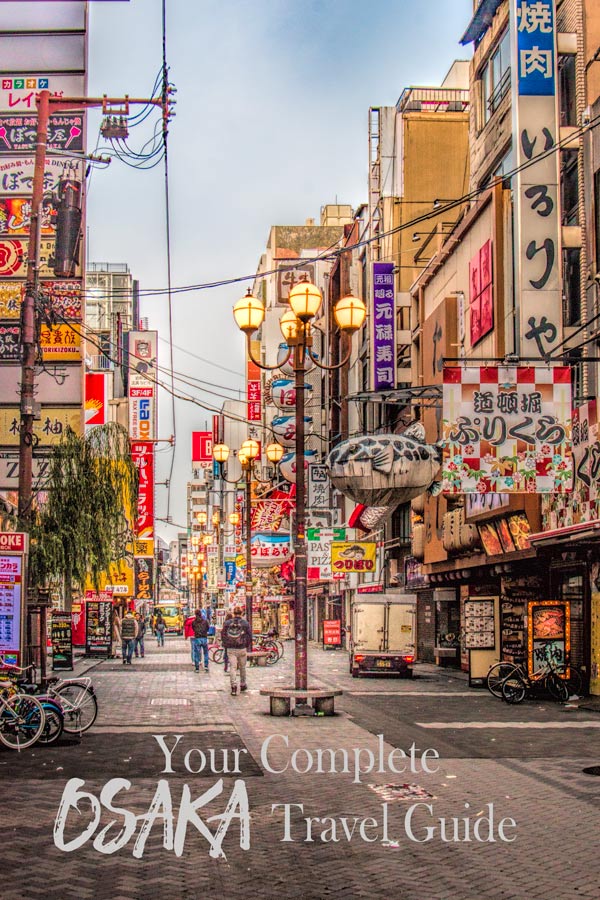
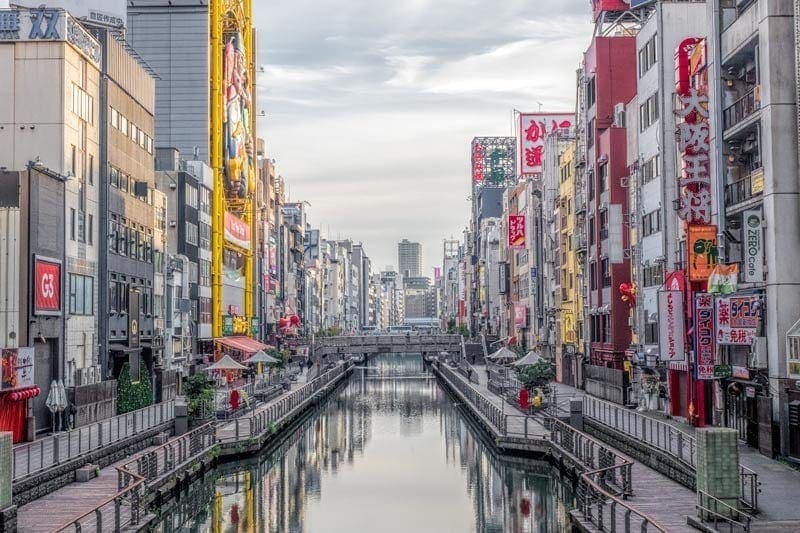


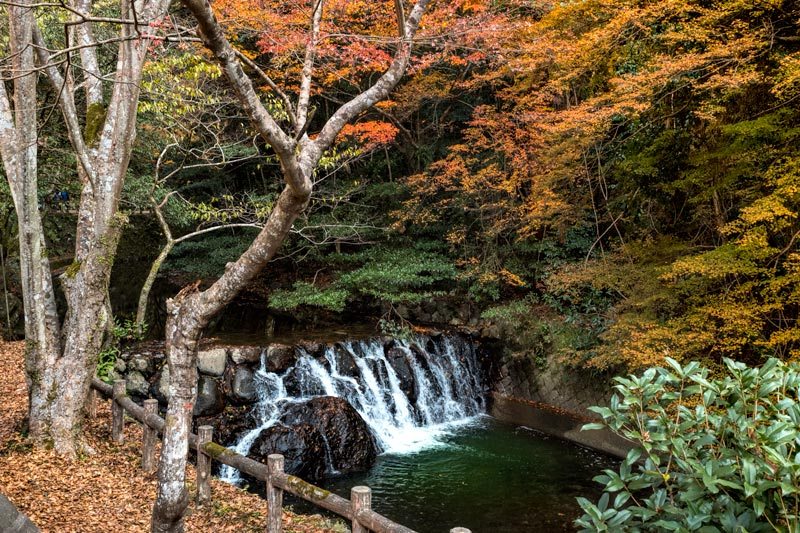
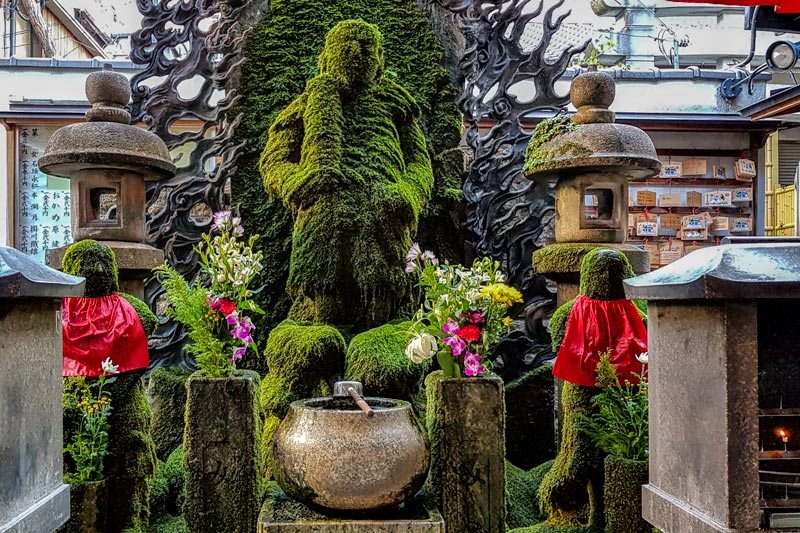

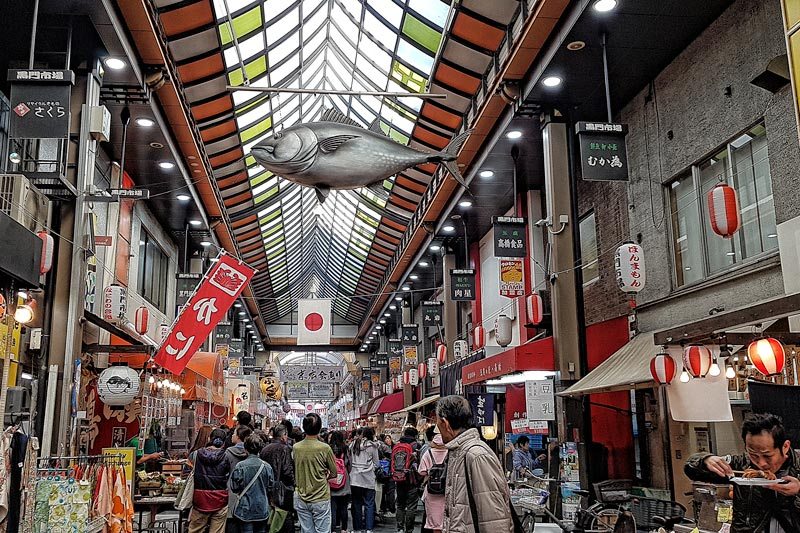
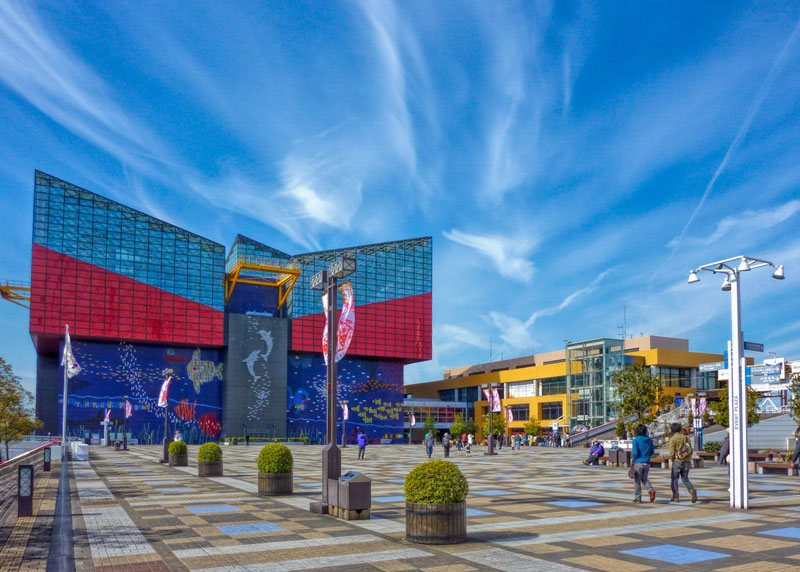

Tracey Butcher
Thursday 26th of December 2019
Hi Toni,
We are going to Osaka in February for two nights where would you recommend to stay as we want to go to Universal one day and do sightseeing the other day.
Cheers Tracey
Tracey
Friday 27th of December 2019
Thank you Toni
I have been following you for awhile and Have taken lots of information from your blogs. I thought they might have been the two to stay at but I thought I should ask if there any other. Thank you once again.
Happy New Year
Toni Broome
Thursday 26th of December 2019
As you also want to explore the city I wouldn't stay out near Universal Studios as it will be less convenient for other things. We like the Namba / Dotonbori area as a base as it is easy to get to from the Shinkansen station and Airport, there are a lot of dining options for all price points and it's a key area you are likely to want to see on your day of sightseeing making it a good place to start or end. Hotel choices depend on budgets and personal preferences but we have used the Swissotel Nankai and the Namba Oriental Hotel recently and they are both an easy walk from the station with larger suitcases.
Ricky
Sunday 20th of October 2019
Hi toni,
Thanks for sharing this site, find it very useful. We are planning to visit japan from dec 24 to jan 4. were planning to stay in osaka from dec 24 to dec 29 (5 days) and dec 30 to jan 4 (5 days) in Tokyo. Do you also have a travel guide in Tokyo? Where should we stay longer? Osaka or Tokyo? Thanks very much.
Ricky
Toni Broome
Monday 21st of October 2019
Hi Ricky, Thanks for getting in touch. A couple of other articles you might find useful are:
- Our guide to things to do in Tokyo - Day trips from Tokyo - Day trips from Kyoto
The first one gives ideas of 50 things we've done and enjoyed in Tokyo, regardless of age and interests most people will find some things in there that they'd want to see and do. Between Osaka and Tokyo, while we enjoy both for different reasons, there is probably more to see and do in Tokyo city than Osaka. Having said that I have also included two other articles, one for each city that highlights some great side trips you can do from a base in either one. I'm guessing you aren't planning to use a JR Pass if you are flying into one city and out of the other which might make some of the options like Nagano or Hiroshima a bit pricey but a lot of the others will work without it. There are also other passes that might work for specific trips or from one of the base points. If you need help with working out those once you know where you want to see let me know as we've used a few over the years and there is an even bigger range that's become available recently.
At the time of year that you are visiting I'd highly recommend incorporating the various winter light-ups in Tokyo into your evening, we tend to pick one of the areas each night for dinner then walk around the lights afterwards, they are in areas like Shiodome (Shimbashi), Roppongi Hills and Omotesando Hills. There are plenty of places to stop in for a drink, or hot drink to warm up at all of them before heading back to your hotel. Just be aware of the 'Cinderella issue', most trains stop at midnight and don't restart until 5 am.
Also with the recent typhoon there was a lot of damage to areas near Tokyo and up the east coast. They fix things very fast but I've been told that Hakone is badly damaged including roads and train tracks and they expect repairs to take some time so if you are planning to go there I would leave bookings until closer to the time and perhaps have an alternate day plan in mind.
Enjoy your trip!
Rachel
Sunday 7th of July 2019
Hi Toni, This is an amazing blog, thank you for sharing with us.I am planning a trip to Japan this November for 4 adults, our itinerary as following: - 4 nights in Tokyo - Train from Tokyo to Osaka for 4 night - In Osaka we stay 10 mins from Dotonbori but 25 mins walk from JR station, we would like to go Osaka Universal Studio, The Aquarium, Umeda Sky Building, and day trip to Kobe or Kyoto - Flight out from Kansai Airport
Is it worth to buy 7 days JR Pass? Can we buy bulletin train ticket from Tokyo to Osaka on the same day travel?
Thank you Rachel
Toni Broome
Sunday 7th of July 2019
Hi Rachel, we wouldn't use the JR Pass for that itinerary, you won't get value from it. The only long trip that you will probably want to use the bullet train for is from Tokyo to Osaka and that is less than half the price of the JR pass. While you could use it again to Kobe it is very close to Osaka and the pass is not necessary, the JR Kobe Rapid only takes around 30 minutes from Osaka station and costs Y410. Also for Kyoto it's not worth using the bullet train, there are better options for time and price if you don't already have the pass.
If you are 10 minutes from Dotonburi, depending on from which side, you are likely close to either Namba station or Shinsaibashi both of which are on the Midosuji Line, a useful line to connect you with Umeda (Osaka) station, Shin Osaka etc. You may find the subway is worthwhile to save a bit of walking and time. We caught it through from Shin-Osaka with full-size luggage (out of peak time) to Namba when we came through from Tokyo in May and it was very easy.
I would suggest you look at getting an IC card which is just a stored value card that you can use on the subways, trains etc in each city for convenience. PASMO, SUICA and ICOCA all work exactly the same way. Also we have an article on the Osaka Amazing Pass and you might want to match that against what you are doing on your days in Osaka to see if that works for you, we have used it for the Aquarium discount and Umeda Sky Building that you mention including.
You can buy bullet train tickets the day you are travelling, although November may be autumn leaves season it is not as busy as some other times of year but if I have a particular train I want to be on I normally pick up the tickets ahead sometime when I am passing through a major station with a ticket office, it doesn't have to be Tokyo Station.
Have a fabulous trip!
Ibadah Mimpi
Saturday 4th of May 2019
wow! There's a lot of things to do in Osaka. This gonna be a wonderful journey according to your list.
Emily Grace
Wednesday 3rd of October 2018
Thanks for this post and photos clicked are simply amazing! In Osaka I have visited to Minoo Falls and Park on my birthday! and I have great memories of this place and after reading your post it reminds me all the fun. Thanks again!! :)
Toni Broome
Saturday 6th of October 2018
Thanks for sharing Emily, it's such a lovely spot up there